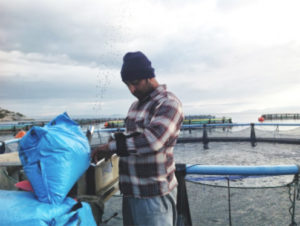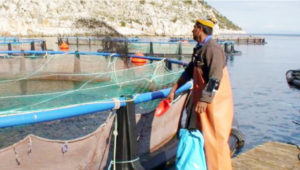Gathering data gleans knowledge about production variables

In its various shapes and forms, aquaculture is one of the most complex animal production industries today. Be it tilapia farming in lakes in Brazil, barramundi grow-out in recirculating plants in Vietnam or salmon cage farming in Norway’s fjords, aquaculture is a biotechnology that encompasses many complex steps, from larval rearing to controlling water chemistry to managing complex feeding processes. Even at the simplest fish or shrimp farms, success depends on the correct balance of applied biology, husbandry and technology.
In the last few decades, research projects around the world have added much knowledge and know-how on the culture of various species using different farming methods. Nutritional requirements for many species are known, and feed production technologies have reached quite advanced levels.
Resources, efficiency
Today aquaculture is called upon to solve some of the critical problems caused by an expanding human population coupled with the unprecedented destruction of fisheries resources. Aquaculture’s growth, however, is leading to pressures on both the environment and raw materials.
In answer, farmers are finding lower-impact feed sources and becoming more efficient in the use of existing resources. Since the public image of aquaculture directly determines the value of what it produces, the industry is also reducing impacts on water resources and seeking greater efficiencies in attaining a sustainable mode of production.
Going forward, research performed in laboratory settings must be more directly related to practices at commercial operations, where variability in the farming environment, diseases and other causes of stress can negatively affect production outcomes. For example, studies in the salmon industry have shown that despite the use of advanced technologies, 10 to 40 percent of the feed used is left uneaten. At pangasius farms, where the species can theoretically be grow with a feed-conversion ratio of 1, conversion values are often above 2.5.
The existing expertise regarding health and sanitation practices, feeds and feeding management, husbandry processes, and operations and human resources management could all, if well implemented, significantly improve the industry’s performance. However, the implementation of this knowledge is a limiting factor for aquaculture today.
Information
The “inventor” of modern business management, Peter Drucker, may not have said it, but the quotation “If you can’t measure it, you can’t improve it” attributed to him is considered a maxim in today’s management science. It basically stresses the key role that information should play in management decisions. This is an area where aquaculture, as many other primary production industries, is very deficient.
There is very little automation in this industry, and due to its complexity, improvements will take a long time. Therefore the men and women working in aquaculture represent the key resource upon which business success or failure will depend. If we are to gather information to better manage our fish and shrimp farms, we need to get the men and women working in the field to gather it in a reliable and timely manner so that it can be used in good management decisions.
Motivation, management
Aquaculture is an industry in which each daily feeding counts toward the success of the business and understanding of the health and environmental conditions matters for the good biological performance of the livestock. Yet in aquaculture companies around the world, the workforce tends to be somewhat poorly paid, poorly trained and usually expected to do repetitive tasks under difficult weather conditions.
No matter how good the processes at a farm are, the people who work in the field must be motivated to do a good job to achieve satisfactory results. Motivation is the result of three factors that impact performance in a positive way: having a purposeful mission, autonomy to progress according to the mission and mastery of the skills necessary to perform well.
These factors should be addressed in any management program, especially in industries like aquaculture. They require a management attitude that values the workforce, but also mechanisms where information is gathered as operations happen, in real time, and feedback given frequently to workers as to the quality of their performance. Staff members who are engaged in their work are motivated. Training should, ideally, be supplied almost continuously to support staff in their everyday decisions.
Aquanetix project
Aquaculture is clearly a complex industry, which today struggles with issues of efficiency and sustainability that can be improved greatly by better management. People play a key role, and improving motivation will deliver results. Data and information link all the above and act as the glue that binds performance, people and management in a way that delivers the further efficiencies needed to make aquaculture even more viable and sustainable.

The Aquanetix project uses technologies that allow real-time data collection by workers and applies the information from every person at a fish or shrimp farm. Data collection focuses on feeding, environmental parameters, stock behavior and health status, infrastructure conditions and other parameters that affect farm performance.
The vast majority of this data has to be collected and recorded by workers at the very moment they perform their assigned tasks. Today we have technologies that make this possible and accessible to even small family businesses through the use of cloud technologies and mobile equipment such as smartphones and electronic tablets.
Data-recording applications can deliver knowledge such as the best growth and feeding models scientists have developed. They can also provide a form of crowd-learning advice to farmers that derives from the experiences of hundreds or thousands of other operations similar to theirs.
Ultimately, gathering all this data in one place allows us to understand the factors that really affect production – whether nutritional, environmental or husbandry-related – in the real world of farms, as opposed to the laboratory.
Editor’s Note: This article is based on the work by Drs. Thomaz and Adamidou to develop better information-based management strategies to improve the performance and sustainability of aquaculture systems. This work was considered for the Novus Global Aquaculture Innovation Award, the first of which was presented by the Global Aquaculture Alliance at the GOAL 2013 conference in Paris, France.
(Editor’s Note: This article was originally published in the January/February 2014 print edition of the Global Aquaculture Advocate.)
Authors
-
Diogo Thomaz, MBA, Ph.D.
Aquanetix
22a Lena Gardens
London W6 7PZ United Kingdom[107,117,46,111,99,46,120,105,116,101,110,97,117,113,97,64,111,103,111,105,100]
-
Stella Adamidou, Ph.D.
Aquanetix
22a Lena Gardens
London W6 7PZ United Kingdom
Tagged With
Related Posts

Innovation & Investment
Aquaculture data-collection app provides cloud coverage
Aquanetix, launched by two fish biologists, employs cloud technology for electronic data collection, enabling farmers to monitor infrastructure, minimize feed losses and make informed operational business decisions based on real-time reports about their stocks.

Aquafeeds
A look at the SME controlled extrusion process
A study was conducted using a Twin-Screw Extruder equipped with Specific Mechanical Energy (SME) and Density Control valves, to determine the effect of SME on the water stability of shrimp feeds. Further research is needed to evaluate the performance.

Responsibility
A look at unit processes in RAS systems
The ability to maintain adequate oxygen levels can be a limiting factor in carrying capacities for RAS. The amount of oxygen required is largely dictated by the feed rate and length of time waste solids remain within the systems.

Aquafeeds
A look at phospholipids in aquafeeds
Phospholipids are the major constituents of cell membranes and are vital to the normal function of every cell and organ. The inclusion of phospholipids in aquafeeds ensures increased growth, better survival and stress resistance, and prevention of skeletal deformities of larval and juvenile stages of fish and shellfish species.


